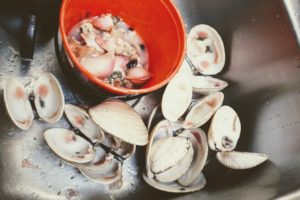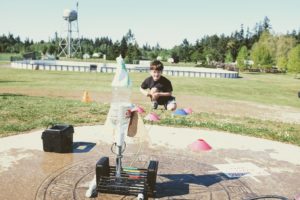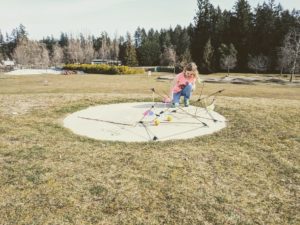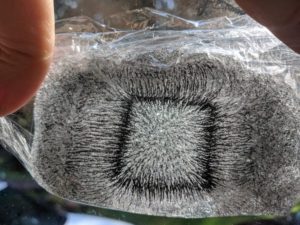This is a guest post from Dr. Erica Saint Clair.
She’ll explain how these five cool summer projects incorporate entertaining,
hands-on science.
1. Go clam digging at the beach
Pack your shovels, roll up your pants, and amp up your next visit to the beach this summer with a seashore to plate challenge.
You won’t need too much in terms of supplies, although I suggest Home Science Tool’s
clam dissection guide.
Kids will learn about the natural habitat of clams, have the chance to do a low tide walk, engage in a cheap and easy dissection project, and then cook up a delicious dinner.
We did our clam dissection with tools from home, but if you want to add an air of expertise to your project you can also check out a variety of great
dissection kits here.

Since you will need a low tide to dig clams, you can also enjoy a low tide beach walk to investigate the diversity of beach animals.
You can add this to the list of cool summer projects if you document what animals you find – which are most prevalent?
What areas had the most animals present (rocky areas, sandy areas, etc.), why?
If you want to learn animal identifications you can even plan a visit to your local library ahead of time to check our a variety of beach naturalist books.
After your beach visit, clam digging, and clam dissection you can take your remaining clams and cook them up into a delicious fried clam dinner (or look up other recipes like clam chowder).
I love this beach visit because it brings so many different aspects of science and learning into one full-day activity, allowing kids of all different learning types to gain new knowledge.
Don’t have a clam beach near you? You can skip the first bit and get your clams from your local grocer. Kids can still engage in the dissection and cooking!
2. Have a blast with a creative sprinkler
Summer fun isn’t the same without a ton of water play!
Instead of just setting up the sprinkler in the backyard, you can help kids learn about engineering and design as they create projectile based projects that will also cool them off.
For example, you could create your own
water rocket that sprays water as it blasts off.
Kids can discover the
science behind how the water rocket works and engineer the look of their rocket.
You can amp up the science by challenging kids to create a rocket that stays in the air the longest or flies the farthest.

If your kids love engineering they can build giant 3-foot tall giant catapults.
Using long bamboo stakes kids can learn lashing and knot tying as they create a pyramid structure to tie slingshot rubber to.
Fill up some water balloons and you have the perfect hot weather water balloon fight!
Kids will have to not only engineer the catapult but will learn about projectile motion as they try to hit their siblings or friends.

Want to build something smaller? You could cool off using a
ping pong catapult and substitute the ping pong with fake snowballs!
The fake snow is safe for animals and will help your yard and plants retain moisture wherever it lands (which can also be another research project – how does fake snow do this?
Why does polyacrylamide absorb so much water?
What is the chemical structure?.
3. Mix up fizzy ice cream
Tired of making regular ice cream with rock salt? Kids can learn about the
chemistry of ice cream making while also having a memorable time by mixing up fizzy ice cream.
What makes this ice cream fizzy? Just like soda pop, this ice cream gets its fizz from carbon dioxide. Instead of using carbon dioxide to make soda like your soda stream, you can use carbon dioxide ice (or dry ice) to make soda flavored ice creams.
This ice cream is faster to make than its rock salt counterpart and brings a breath of fresh air to a cool summer treat. You’ll need dry ice from your local butcher and the regular ice cream ingredients.
You can find my favorite
fizzy ice cream recipe here. Have access to a research lab? You can also use liquid nitrogen to make ice cream – do you think this type would taste fizzy? Why or why not?
Be sure to purchase extra dry ice for kids to mix into various liquids, the “oohs” and “ahhs” of learning about phase changes will make your heart sing. Bonus: add a little soap to the liquids to have a bubble making machine!
4. Use the sun to make art
Cyanotype sun printing is a fun way of teaching how light, or energy, can change chemical bonds.
I love that kids get to blend art and science in this activity, allowing them to enjoy engaged learning instead of just workbook pages.
You can make this project an easy afternoon activity with
sun print paper or opt for a more elaborate project where kids mix their own cyanotype inks and paint them onto garments.
For younger learners this project is a real-life way to learn about transparency, opacity, filter colors, and more!
5. Mix up a scientific slime
Have your kids been begging to make slime but you just don’t see the point yet? What if you could make scientific slime?
You read that right, scientific slime. Cool summer projects, remember, can be done indoors.
I have a whole bunch of ideas on how kids can use slime as a tool for inquiry, my favorite being
magnetic slime. You will need a
slime kit, iron filings, and
magnets for this project.
The stronger the magnet the better, but having a variety of magnets and electromagnets are the perfect way to build out this afternoon of inquiry.
When I first made this magnetic slime I about fell off my chair when it worked out how I wanted, making the invisible magnetic field lines appear. The trick to scientific magnetic slime is putting in just enough, but not too much iron filings.
You want to be able to see through the slime when it is held up to the light.
 Dr. Erica Saint Clair has a PhD in Physics from Boston University where she worked on modifying photoactive proteins to be more useful in the field of Optogenetics. Spending years in the lab she decided to switch gears after her two daughters were born to focus on bringing real science into the realm of fun science. Over the last three years, she has taught in a variety of elementary classrooms both in person and online while starting up her business, Rosie Research. The mission of Rosie Research is to allow kids to learn real science with fun science.
Dr. Erica Saint Clair has a PhD in Physics from Boston University where she worked on modifying photoactive proteins to be more useful in the field of Optogenetics. Spending years in the lab she decided to switch gears after her two daughters were born to focus on bringing real science into the realm of fun science. Over the last three years, she has taught in a variety of elementary classrooms both in person and online while starting up her business, Rosie Research. The mission of Rosie Research is to allow kids to learn real science with fun science. Since you will need a low tide to dig clams, you can also enjoy a low tide beach walk to investigate the diversity of beach animals.
You can add this to the list of cool summer projects if you document what animals you find – which are most prevalent?
What areas had the most animals present (rocky areas, sandy areas, etc.), why?
If you want to learn animal identifications you can even plan a visit to your local library ahead of time to check our a variety of beach naturalist books.
After your beach visit, clam digging, and clam dissection you can take your remaining clams and cook them up into a delicious fried clam dinner (or look up other recipes like clam chowder).
I love this beach visit because it brings so many different aspects of science and learning into one full-day activity, allowing kids of all different learning types to gain new knowledge.
Don’t have a clam beach near you? You can skip the first bit and get your clams from your local grocer. Kids can still engage in the dissection and cooking!
Since you will need a low tide to dig clams, you can also enjoy a low tide beach walk to investigate the diversity of beach animals.
You can add this to the list of cool summer projects if you document what animals you find – which are most prevalent?
What areas had the most animals present (rocky areas, sandy areas, etc.), why?
If you want to learn animal identifications you can even plan a visit to your local library ahead of time to check our a variety of beach naturalist books.
After your beach visit, clam digging, and clam dissection you can take your remaining clams and cook them up into a delicious fried clam dinner (or look up other recipes like clam chowder).
I love this beach visit because it brings so many different aspects of science and learning into one full-day activity, allowing kids of all different learning types to gain new knowledge.
Don’t have a clam beach near you? You can skip the first bit and get your clams from your local grocer. Kids can still engage in the dissection and cooking!
 If your kids love engineering they can build giant 3-foot tall giant catapults.
Using long bamboo stakes kids can learn lashing and knot tying as they create a pyramid structure to tie slingshot rubber to.
Fill up some water balloons and you have the perfect hot weather water balloon fight!
Kids will have to not only engineer the catapult but will learn about projectile motion as they try to hit their siblings or friends.
If your kids love engineering they can build giant 3-foot tall giant catapults.
Using long bamboo stakes kids can learn lashing and knot tying as they create a pyramid structure to tie slingshot rubber to.
Fill up some water balloons and you have the perfect hot weather water balloon fight!
Kids will have to not only engineer the catapult but will learn about projectile motion as they try to hit their siblings or friends.
 Want to build something smaller? You could cool off using a ping pong catapult and substitute the ping pong with fake snowballs!
The fake snow is safe for animals and will help your yard and plants retain moisture wherever it lands (which can also be another research project – how does fake snow do this?
Why does polyacrylamide absorb so much water?
What is the chemical structure?.
Want to build something smaller? You could cool off using a ping pong catapult and substitute the ping pong with fake snowballs!
The fake snow is safe for animals and will help your yard and plants retain moisture wherever it lands (which can also be another research project – how does fake snow do this?
Why does polyacrylamide absorb so much water?
What is the chemical structure?.
 Dr. Erica Saint Clair has a PhD in Physics from Boston University where she worked on modifying photoactive proteins to be more useful in the field of Optogenetics. Spending years in the lab she decided to switch gears after her two daughters were born to focus on bringing real science into the realm of fun science. Over the last three years, she has taught in a variety of elementary classrooms both in person and online while starting up her business, Rosie Research. The mission of Rosie Research is to allow kids to learn real science with fun science.
Dr. Erica Saint Clair has a PhD in Physics from Boston University where she worked on modifying photoactive proteins to be more useful in the field of Optogenetics. Spending years in the lab she decided to switch gears after her two daughters were born to focus on bringing real science into the realm of fun science. Over the last three years, she has taught in a variety of elementary classrooms both in person and online while starting up her business, Rosie Research. The mission of Rosie Research is to allow kids to learn real science with fun science.




